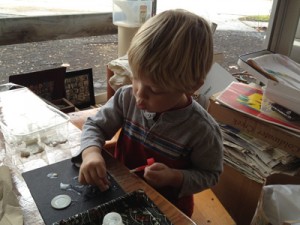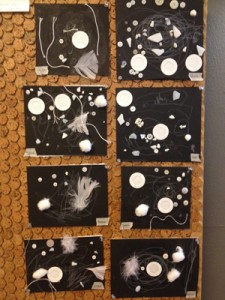By Kerry Drake
A long, long, long time ago I was a preschooler working with tempera paint. Though it was years ago, I have a distinct memory of one particular painting session.
Here is the memory: I was working at the easel. I remember being by myself and very engaged by the different colored paint lines on the paper. I remember studying the shapes and colors that my brush strokes created. And then this: the teacher came alongside me and said, “What is it?”
 What is it? Quickly my preschooler brain began processing…. Oh, it needs to be something. Oh, I need to have an answer for my teacher…. I tried to imagine the paint lines into something that could be like a correct answer to give. I added dots for an eyes, and said, “It’s a monster.” She loved it. I was happy she loved it. But my approach to art was sure to have changed in that moment, given I was a child aiming to please my teachers.
What is it? Quickly my preschooler brain began processing…. Oh, it needs to be something. Oh, I need to have an answer for my teacher…. I tried to imagine the paint lines into something that could be like a correct answer to give. I added dots for an eyes, and said, “It’s a monster.” She loved it. I was happy she loved it. But my approach to art was sure to have changed in that moment, given I was a child aiming to please my teachers.
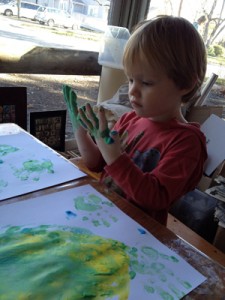 Now that my role is reversed, I work very hard to silence myself alongside the children as they are creating. I view the special (and new!) studio space as a reverent, quiet area, where two to four children can explore and process the variety of materials on their own terms and in their own time. It is not always easy for me, of course. When a child asks me if I like his or her art, I mostly want to say, “Yes! Very much so!” But if I blurt that out accidentally, I try to follow up with specifics about a color, a line, a texture that stands out to me. More so, I try to ask the budding artist what s/he thinks about the creation, and I work to note how focused or dedicated the child is working. I really try to not encourage the child to put a value judgement on the product, but I do concentrate on praising and noting effort. And I’ve gotten mostly versed at not asking “what is it?” during the process.
Now that my role is reversed, I work very hard to silence myself alongside the children as they are creating. I view the special (and new!) studio space as a reverent, quiet area, where two to four children can explore and process the variety of materials on their own terms and in their own time. It is not always easy for me, of course. When a child asks me if I like his or her art, I mostly want to say, “Yes! Very much so!” But if I blurt that out accidentally, I try to follow up with specifics about a color, a line, a texture that stands out to me. More so, I try to ask the budding artist what s/he thinks about the creation, and I work to note how focused or dedicated the child is working. I really try to not encourage the child to put a value judgement on the product, but I do concentrate on praising and noting effort. And I’ve gotten mostly versed at not asking “what is it?” during the process.
In order to keep the focus off of “product oriented” art, I strive to offer long term projects in the studio where we have time and space to return to our creations. Our projects take weeks to months of returning to the art, thinking about color or shapes, spending time and not being rushed. In this way, not only does each child’s thought process become evident, but the exploration deepens, as well.
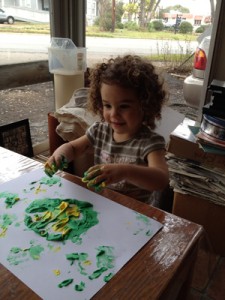 Having a reverent space like the studio means sometimes our process art and thinking is not as evident or overt for you, the parents. I try to hang projects out and about when they feel mostly completed for your viewing. Rarely (but sometimes) do we do one-day turn around art. Many of the 2-D pieces I have given to classroom teachers, and this art may turn up in your child’s end of year book. When I work in the classroom on art projects instead of the studio, I also try to maintain a quiet, non-judgemental space for the child to create, knowing as I do how asking what something “is” in an art creation can lead to a child shutting down in the process.
Having a reverent space like the studio means sometimes our process art and thinking is not as evident or overt for you, the parents. I try to hang projects out and about when they feel mostly completed for your viewing. Rarely (but sometimes) do we do one-day turn around art. Many of the 2-D pieces I have given to classroom teachers, and this art may turn up in your child’s end of year book. When I work in the classroom on art projects instead of the studio, I also try to maintain a quiet, non-judgemental space for the child to create, knowing as I do how asking what something “is” in an art creation can lead to a child shutting down in the process.
In order to make visible some of what happens behind the studio door, here are some pictorial snapshots the work we have been doing over the months of the year: these range from basic introduction to texture and color (shaving cream art with two year olds), to wooden or paper structures with the 3’s, to creating our own shields (with Nadia’s 4’s), to modeling clay stamps in Maaike’s classroom. Hopefully these pictures will give you snippets of the view in the atelier: both process and eventual pieces!
| Paper sculpture art: Susan’s 3’s | |
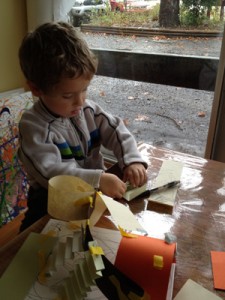 |
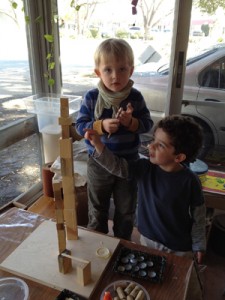 |
| Sometimes we further classroom discussions through individual work in the studio |
 |
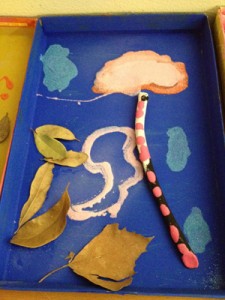 |
 |
 |
 |
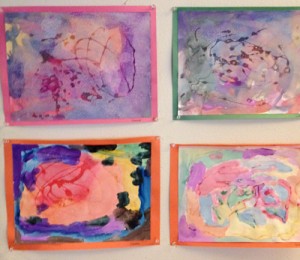 |
 |
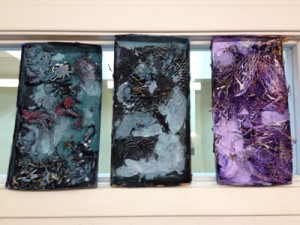 |
 |
Thank you for the time and space to explore with your children!

